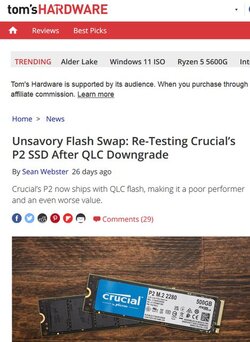In Samsung's case, I'd say No because it seems they do publish their post-cache write results (see image and quote above). The other drives don't mention those, so, yes, while measurable, in the case of the other drives that don't mention it, it performs within the advertised specifications as they (unlike Samsung) don't appear to show those metrics. But again, I'm not a lawyer. I see what you're saying, but sadly, there's a lot of intentional ambiguity in marketing. 
The only notification that the Samsung drives are different is the label on the drive. I don't think it's on the box. Not sure if the others even did that. Clearly, these drives don't perform (significantly) above their rated speeds. So, no, the original doesn't mean they are getting more than advertised, just that others are getting LESS with the new drive (because they actually advertised it).
The only notification that the Samsung drives are different is the label on the drive. I don't think it's on the box. Not sure if the others even did that. Clearly, these drives don't perform (significantly) above their rated speeds. So, no, the original doesn't mean they are getting more than advertised, just that others are getting LESS with the new drive (because they actually advertised it).
